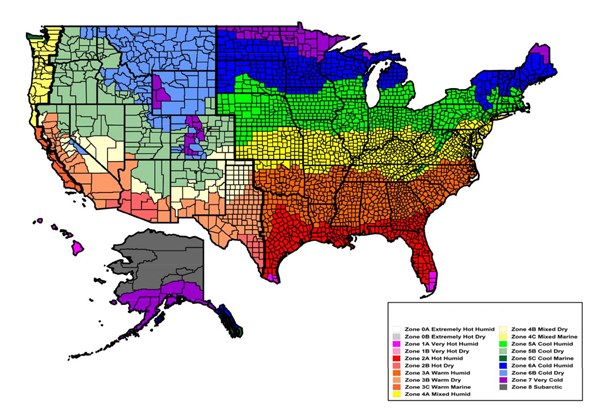2021 ICC Building Code Updates Part 1 – Insulation
The next few SpecTopics will be a multi-part series focusing on the upcoming changes to the 2021 International Code Council's (ICC) International Building Code (IBC) and International Energy Conservation Code (IECC).
The final proposals of 2019 were heard in Las Vegas, Nevada, in October, and the ICC has released their online consensus vote results. While not an exhaustive list, the next few SpecTopics will highlight forthcoming changes, with each post focusing on a certain area of the building envelope.
Let's start with the adoption of the ASHRAE 169-2013 map for climate zone definitions in IECC Section C301.1 General. This adoption modifies the U.S. and Canadian Climate Zones map, by county, and is used to determine the insulation and performance metrics for a project within that county.

Additional insulation-related changes include:
Adding IECC Section C401.3 Thermal Envelope Certificate, which adds a requirement for a physical thermal envelope certificate which will contain information on R-values of insulation used throughout the building and how it should be displayed.
Adding IECC Section C402.1.4.1.1 Tapered, Above-Deck Insulation Based on Thickness, which clarifies the calculation method for use of tapered insulation and the use of "average thickness in inches" in lieu of arithmetic or volumetric averages.
Modifying IECC Section C402.2.4 Slabs-on-Grade, for the installation of perimeter foundation and slab-on-grade instructions from prescriptive to mandatory. This clarifies the method of installation is mandatory when present.
Clarifying IECC Section C503.3.1 Roof Replacement, that no matter what method is used to determine thermal envelope requirements for a roof replacement, a reduction in the total R-Value or an increase in the total U-Value shall not occur.
For more information on the code development process, visit the ICC website here.
Contact Craig Tyler at [email protected] with further questions.
Stay tuned for Part 2 – Roofing, coming next month.
The final proposals of 2019 were heard in Las Vegas, Nevada, in October, and the ICC has released their online consensus vote results. While not an exhaustive list, the next few SpecTopics will highlight forthcoming changes, with each post focusing on a certain area of the building envelope.
Let's start with the adoption of the ASHRAE 169-2013 map for climate zone definitions in IECC Section C301.1 General. This adoption modifies the U.S. and Canadian Climate Zones map, by county, and is used to determine the insulation and performance metrics for a project within that county.

Additional insulation-related changes include:
Adding IECC Section C401.3 Thermal Envelope Certificate, which adds a requirement for a physical thermal envelope certificate which will contain information on R-values of insulation used throughout the building and how it should be displayed.
Adding IECC Section C402.1.4.1.1 Tapered, Above-Deck Insulation Based on Thickness, which clarifies the calculation method for use of tapered insulation and the use of "average thickness in inches" in lieu of arithmetic or volumetric averages.
Modifying IECC Section C402.2.4 Slabs-on-Grade, for the installation of perimeter foundation and slab-on-grade instructions from prescriptive to mandatory. This clarifies the method of installation is mandatory when present.
Clarifying IECC Section C503.3.1 Roof Replacement, that no matter what method is used to determine thermal envelope requirements for a roof replacement, a reduction in the total R-Value or an increase in the total U-Value shall not occur.
For more information on the code development process, visit the ICC website here.
Contact Craig Tyler at [email protected] with further questions.
Stay tuned for Part 2 – Roofing, coming next month.
Up Next
February 19, 2020
FM’s VSH Testing – Very Severe Hail
FM Global and FM Approvals have created a Very Severe Hail (VSH) impact resistance classification.
February 05, 2020
Spray Foam for Walls – The Perfect Wall
The challenge with every design is making sure that it will work in a specific environment.
January 22, 2020
Wood Nailers for Roofing
Wood nailers are often overlooked, but they are a very important component of a successful roof assembly.
